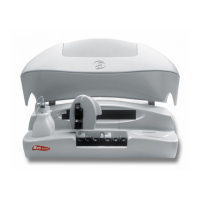13
1.2. FUNCTIONING OF THE ANALYZER
The A25 analyzer is an automatic random access analyzer specially designed for performing biochemical and turbidimetric
clinical analyses. The analyzer performs patient-by-patient analyses and enables the continual introduction of samples.
The analyzer is controlled from a dedicated PC that is permanently communicated to the instrument. The program,
installed on the computer, keeps the user constantly informed of the status of the analyzer and the progress of the
analyses. As results are obtained, the computer shows them to the user immediately.
When a Work Session is begun, the analyzer proposes performing the blanks, calibrators and controls programd for the
measurement procedures it is to carry out. The user may choose between performing the blanks and the calibrators or
not. If they are not performed, the analyzer uses the last available memorised data. The controls can also be activated or
not. During a session, while the analyzer is working, the user can introduce new normal or urgent samples to be
analyzed. Each time a new sample is added, the analyzer automatically proposes the possible new blanks, calibrators
or controls to be performed. A work session can remain open for one or more days. When a session is closed and
another new session is opened (Reset Session), the analyzer again proposes performing the blanks, calibrators and
controls. It is recommended that the session is reset each working day.
The analyzer determines the concentrations of the analytes based on optical absorbance measurements. To measure
the concentration of a certain analyte in a sample, the analyzer uses a pipette to take a specific volume of the sample
and the corresponding reagent, quickly thermostatises them in the needle itself and dispenses them into the reactions
rotor. The very dispensing speed together with the geometry of the reaction well causes the mixture to be shaken and the
chemical reaction begins. In the bireagent modes, the reaction begins when the analyzer later dispenses a second
reagent in the same reaction well. The reactions can be biochemical or turbidimetric. In both cases, the reaction or the
chain of reactions produced generate substances that attenuate certain wavelengths, either by absorption or by dispersion.
Comparing the light intensity of a certain wavelength that crosses a well when there is a reaction and when there is not
a reaction can determine the concentration of the corresponding analyte. This comparison is quantified with the physical
magnitude called absorbance. In some cases, the concentration is a direct function of the absorbance, and in other
cases, it is a function of the variation of the absorbance over time, depending on the analysis mode.
1.3. TRANSPORT AND RESHIPMENT OF THE ANALYZER
If the analyzer is to be reshipped or moved using a transport vehicle, it is important to block the operating arm and use the
original packaging to ensure that the apparatus is not damaged. To package the instrument, we recommend you follow
the following instructions: (on the unpackaging instructions sheet).

